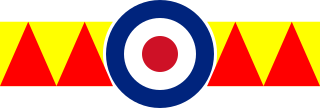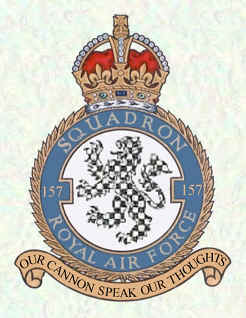Related Research Articles

The Bristol Type 156 Beaufighter is a British multi-role aircraft developed during the Second World War by the Bristol Aeroplane Company. It was originally conceived as a heavy fighter variant of the Bristol Beaufort torpedo bomber. The Beaufighter proved to be an effective night fighter, which came into service with the Royal Air Force (RAF) during the Battle of Britain, its large size allowing it to carry heavy armament and early airborne interception radar without major performance penalties.

The Desert Air Force (DAF), also known chronologically as Air Headquarters Western Desert, Air Headquarters Libya, the Western Desert Air Force, and the First Tactical Air Force (1TAF), was an Allied tactical air force created from No. 204 Group RAF under RAF Middle East Command in North Africa in 1941 to provide close air support to the British Eighth Army against Axis forces. Throughout the Second World War, the DAF was made up of squadrons from the Royal Air Force (RAF), the South African Air Force (SAAF), the Royal Australian Air Force (RAAF), the United States Army Air Forces (USAAF) and other Allied air forces.

The Avro 679 Manchester was a British twin-engine heavy bomber developed and manufactured by the Avro aircraft company in the United Kingdom. While not being built in great numbers, it was the forerunner of the famed and vastly more successful four-engined Avro Lancaster, which was one of the most capable strategic bombers of the Second World War.

The Lockheed Ventura is a twin-engine medium bomber and patrol bomber of World War II.

No. 29 Squadron of the Royal Air Force was first raised as a unit of the Royal Flying Corps in 1915, and is one of the world's oldest fighter squadrons. The second British squadron to receive the Eurofighter Typhoon, it is currently the Operational Conversion Unit (OCU) for the Typhoon.

No. 27 Squadron of the Royal Air Force operates the Boeing Chinook from RAF Odiham.

No. 488 Squadron was the name given to two distinct Royal New Zealand Air Force squadrons during the Second World War. Both were formed under Article XV of the Empire Air Training Scheme and served under the operational command of the Royal Air Force.

Royal Air Force Scorton or more simply RAF Scorton is a former Royal Air Force satellite station located next to the village of Scorton in North Yorkshire, England. The base was opened in October 1939 as part of 13 Group RAF Fighter Command and a satellite station of RAF Catterick. It was used by the Royal Air Force, the Royal Canadian Air Force, and the United States Army Air Forces Ninth Air Force during the war.

No. 247 Squadron was formerly a squadron of the Royal Air Force. It was also known as No. 247 Squadron in recognition of the donations made by the British communities of the foreign concessions established on the Chinese coast. The financial gift to provide two fighter squadrons also included the badge in the form of a scroll with Chinese characters Cheu Feng meaning "fierce wind" or Hurricane, and the motto "Rise from the East". The squadron was heavily involved in air operations during the Second World War, and the defence of the United Kingdom during the early years of the Cold War.
No. 684 Squadron RAF was a photo-reconnaissance squadron of the Royal Air Force from 1943 to 1946.

No. 455 Squadron was a Royal Australian Air Force (RAAF) torpedo bomber squadron during World War II and became famous as part of the "ANZAC Strike Wing" that was formed from Australian and New Zealand squadrons. Raised in early 1941, mainly from Australian personnel, the squadron served over Europe during the war, operating from various bases in the United Kingdom; it also briefly sent a detachment to the Soviet Union in 1942. Operating Handley Page Hampdens and Bristol Beaufighters, the squadron mainly undertook anti-shipping and anti-submarine operations during the war. It was disbanded in May 1945 following the cessation of hostilities against Germany.
No. 169 Squadron RAF was a tactical reconnaissance and later a night intruder squadron of the Royal Air Force during World War II.
No. 680 Squadron RAF was a photo-reconnaissance squadron of the Royal Air Force, active during the Second World War.

No. 604 Squadron RAF was a squadron of the Royal Air Force noted for its pioneering role the development of radar-controlled night-fighter operations. The squadron was established in March 1930 at RAF Hendon as a day-bomber squadron of the Royal Auxiliary Air Force. In July 1934, the squadron transitioned to two-seat fighters. Shortly after the commencement of World War II in 1939, the squadron was reassigned to a night-fighter role.

No. 157 Squadron RAF was a Royal Air Force Squadron active as a night fighter unit in the Second World War.

Raymond "Chaz" Bowyer was a Royal Air Force armaments and explosives instructor who, after he retired from service, wrote and edited over forty books relating to the operations, aircraft, and men of the Royal Flying Corps, Royal Air Force, and Royal Naval Air Service. He also edited for publication the memoirs of the pilots C.P.O. Bartlett, Eric Crundall, and Gwilym H. Lewis.
References
Notes
Bibliography
- Bingham, Victor. Bristol Beaufighter. Shrewsbury, UK: Airlife Publishing, Ltd., 1994. ISBN 1-85310-122-2.
- Bowyer, Chaz. Beaufighter. London: William Kimber, 1987. 0-71830-647-3.
- Bowyer, Chaz. Beaufighter at War. London: Ian Allan Ltd., 1994. ISBN 0-7110-0704-7.
- Franks, Richard A. The Bristol Beaufighter, a Comprehensive Guide for the Modeller. Bedford, UK: SAM Publications, 2002. ISBN 0-9533465-5-2.
- Hall, Alan W. Bristol Beaufighter (Warpaint No. 1). Dunstable, UK: Hall Park Books, 1995.
- Howard. "Bristol Beaufighter-the inside story". Scale Aircraft Modelling, Vol. 11, No. 10, July 1989.
- Innes, Davis J. Beaufighters over Burma – 27 Sqn RAF 1942–45. Poole, Dorset, UK: Blandford Press, 1985.
- Francis K. Mason Archive: Bristol Beaufighter. Oxford, UK: Container Publications.
- Moyes, Philip J.R. The Bristol Beaufighter I & II (Aircraft in Profile Number 137). Leatherhead, Surrey, UK: Profile Publications Ltd., 1966.
- Parry, Simon W. Beaufighter Squadrons in Focus. Red Kite, 2001. ISBN 0-9538061-2-X.
- Scutts, Jerry. Bristol Beaufighter (Crowood Aviation Series). The Crowood Press Ltd., 2004. ISBN 1-86126-666-9.
- Scutts, Jerry. Bristol Beaufighter in Action (Aircraft number 153). Carrollton, USA: Squadron/Signal Publications, 1995. ISBN 0-89747-333-7.
- Thomas, Andrew. Beaufighter Aces of World War 2. Botley, UK: Osprey Publishing, 2005. ISBN 1-84176-846-4.
- Wilson, Stewart. Beaufort, Beaufighter and Mosquito in Australian Service. Weston, ACT, Australia: Aerospace Publications, 1990. ISBN 0-9587978-4-6.